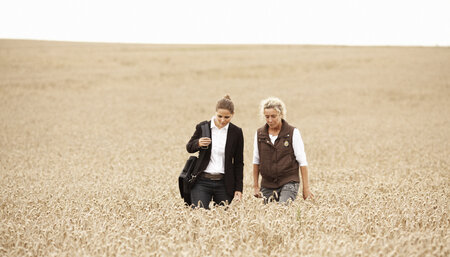Optimizing operational performance of field spraying from a task time and capacity perspective
Arable Vegetables Fruit ScandinaviaOptimizing the operational performance of field spraying from a task time and capacity perspective
In Flagship Innovation Experiment 3 “Digitizing farm machinery produced by SMEs” the overall objectives are to ensure support for agricultural machinery producing SMEs to ensure that the digitized products meet the farmers' requirements. As part of this work Senior Scientist Claus Aage Grøn Sørensen, Department of Electrical and Computer Engineering, Aarhus University, has made a report in collaboration with Martin Dyhrman Sørensen, Danfoil A/S, where the focus is to develop a model to determine how different field tasks performed by the farmers affect operational performance and costs for the spraying operation. The model looks at: tank size, spraying speed and application rate, affect the capacity, CO2 emission, amount of road transport, total spraying cost including depreciation and interest, total time consumption and initial investment of the sprayer.
Abstract:
 An important aspect of managing a farm is to acquire and operate the optimized machinery items in terms of size and capacity. This decision should be supported by analyzing the capacity and costs (variable and fixed costs) of the operation. This optimizes the operational performance (capacity) and contribution margin (costs) for the specific machine and thus optimizing the lifetime overall performance of the operation. However, farmers tend to forget this long-term aspect of the operational costs and instead focus on the initial investment of the equipment. This runs the risk over time of employing ineffective machinery, resulting in loss of overall farm competitiveness. As an example, often only the in-field tasks are considered, which distort the overall effects of changed spraying speed and application rate.
An important aspect of managing a farm is to acquire and operate the optimized machinery items in terms of size and capacity. This decision should be supported by analyzing the capacity and costs (variable and fixed costs) of the operation. This optimizes the operational performance (capacity) and contribution margin (costs) for the specific machine and thus optimizing the lifetime overall performance of the operation. However, farmers tend to forget this long-term aspect of the operational costs and instead focus on the initial investment of the equipment. This runs the risk over time of employing ineffective machinery, resulting in loss of overall farm competitiveness. As an example, often only the in-field tasks are considered, which distort the overall effects of changed spraying speed and application rate.
The focus of this report is to develop a model to determine how the parameters: i) tank size, ii) spraying speed and application rate, affect the capacity, CO2 emission, amount of road transport, total spraying cost including depreciation and interest, total time consumption and initial investment of the sprayer. Thus, giving informed guidelines from which, the farmer can decide how the optimal sprayer for his farm should be specified from an operational aspect. The agronomic aspect is outside the scope of this article, but is well documented in the literature (e.g., Matthews et al., 2014).
 Results show that lowering the application rate (water volume) is a key factor in optimizing the operational performance and costs for the spraying operation. It is shown that in conventional crops, reduction of the water volume rate can provide an additional contribution margin of between 15 to 18% depending upon 5 or 6 treatments in the season. Furthermore, a reduction of the CO2 emission by 29% can be achieved at the same time due to reduced transport to/from the filling location.
Results show that lowering the application rate (water volume) is a key factor in optimizing the operational performance and costs for the spraying operation. It is shown that in conventional crops, reduction of the water volume rate can provide an additional contribution margin of between 15 to 18% depending upon 5 or 6 treatments in the season. Furthermore, a reduction of the CO2 emission by 29% can be achieved at the same time due to reduced transport to/from the filling location.
Download the full report as PDF:
Optimizing operational performance of field spraying from a task time and capacity perspective
Claus Aage Grøn Sørensen, Professor at the Department of Electrical and Computer Engineering, Aarhus University
Henrik Mortensen, Agricultural Technician at the Department of Electrical and Computer Engineering, Aarhus University
Martin Dyhrman Sørensen, CEO at Danfoil A/S
